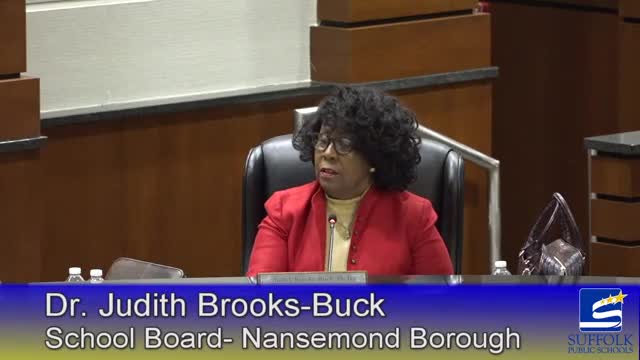Board members clash over school visit policy confusion
June 14, 2024 | SUFFOLK CITY PBLC SCHS, School Districts, Virginia

This article was created by AI summarizing key points discussed. AI makes mistakes, so for full details and context, please refer to the video of the full meeting. Please report any errors so we can fix them. Report an error »

In a recent school board meeting, members engaged in a heated discussion regarding a proposed policy aimed at increasing board member engagement in schools. The debate centered around the clarity and intent of the policy, with board member Riddick expressing concerns that his previous requests for collective school visits were being misinterpreted as individual engagements. He emphasized the importance of board unity and the need for members to tour schools together to better understand the diverse needs of the community.
Riddick highlighted that past practices, such as community tours, had been beneficial for fostering understanding among board members and suggested that the current policy did not adequately reflect this spirit. He pointed out discrepancies between the board's intentions and actions, urging for a clearer definition of the policy's goals to ensure alignment with the board's collective mission.
Another board member voiced opposition to the proposed policy, arguing that it would impose more restrictions on board members rather than facilitate their presence in schools. Concerns were raised about the feasibility of committing to 84 school visits per year, questioning the practicality of such a requirement given the board's other obligations.
The discussion revealed a broader issue of communication and collaboration within the board, with members expressing frustration over ongoing miscommunication and the need for a cohesive approach to school engagement. As the meeting progressed, members acknowledged the necessity of refining the policy to better serve both the board and the schools.
Ultimately, the board moved towards a vote on the policy, with members eager to resolve the ongoing debate and establish a clear framework for their involvement in schools. The outcome of the vote remains to be seen, but the discussions highlighted the critical need for unity and clarity in the board's approach to community engagement.
Riddick highlighted that past practices, such as community tours, had been beneficial for fostering understanding among board members and suggested that the current policy did not adequately reflect this spirit. He pointed out discrepancies between the board's intentions and actions, urging for a clearer definition of the policy's goals to ensure alignment with the board's collective mission.
Another board member voiced opposition to the proposed policy, arguing that it would impose more restrictions on board members rather than facilitate their presence in schools. Concerns were raised about the feasibility of committing to 84 school visits per year, questioning the practicality of such a requirement given the board's other obligations.
The discussion revealed a broader issue of communication and collaboration within the board, with members expressing frustration over ongoing miscommunication and the need for a cohesive approach to school engagement. As the meeting progressed, members acknowledged the necessity of refining the policy to better serve both the board and the schools.
Ultimately, the board moved towards a vote on the policy, with members eager to resolve the ongoing debate and establish a clear framework for their involvement in schools. The outcome of the vote remains to be seen, but the discussions highlighted the critical need for unity and clarity in the board's approach to community engagement.
View full meeting
This article is based on a recent meeting—watch the full video and explore the complete transcript for deeper insights into the discussion.
View full meeting
